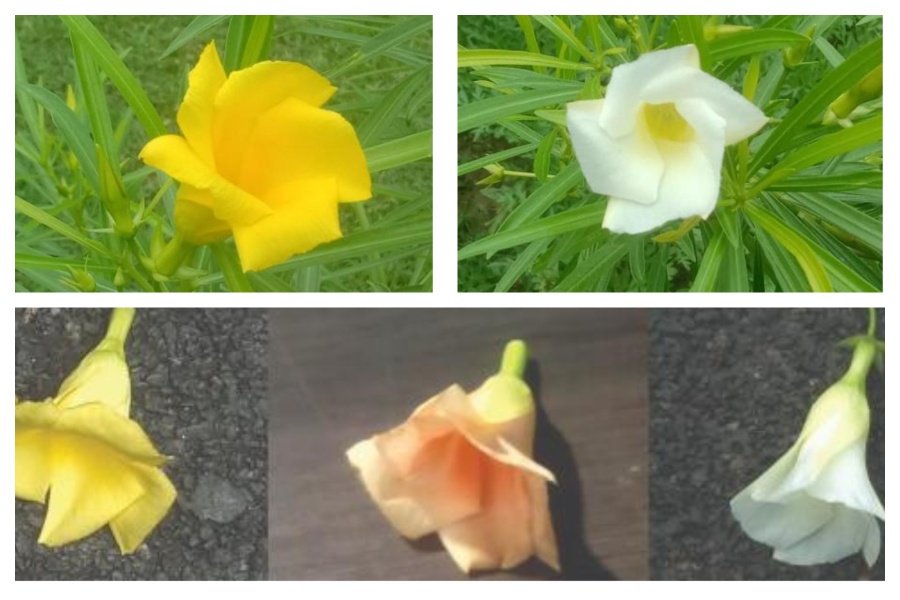Funnel-shaped flowers, spiraled and twisted, and usually, a vibrant sunny yellow in colour. Though named Yellow Oleander, flowers of this plant can vary in colour.
The Yellow Oleander is an evergreen shrub or a small tree that typically grows to a height of 13 to 27 feet. The leaves are linear, five or six inches long, glossy green, grouped in spirals. Its flowers are funnel-shaped, brilliant yellow, and spirally twisted and there are several cultivars with yellow, orange/ peach, and white flowers.
Its fruits have a diameter of four to five centimetres, are fairly spherical, and are slightly meaty. The fruits, which are initially green in colour, become black as they ripen. The Yellow Oleander is widely cultivated in tropical and subtropical regions.
The botanical name of this plant is Cascabela Thevetia. The genus Cascabela belongs to the subfamily Rauvolfioideae (usually with milky latex) and comprises six species. Cascabela Thevetia is native to tropical America, from Mexico to Peru. It has been introduced and can be found in North America, the West Indies, Southern Asia, Australia, East Timor, Kenya, Tanzania, Uganda, Anguilla, Cuba, Hawaii, French Polynesia, Fiji, and other islands in the Pacific and Indian Ocean.
Yellow Oleander is a robust yet toxic tropical shrub that requires mindful care. Special attention should be given to its high toxicity, making it an unsuitable choice for households with pets or small children. No part of the plant must be ingested.
Water: Yellow Oleander is comfortable to a balance of moisture and well-draining conditions. This species exhibits moderate drought tolerance and thrives with humidity levels similar to its native habitat. For optimal health, watering should be done once every one to two days, allowing the soil to dry slightly. As an outdoor plant, it benefits significantly from mulching to retain soil moisture during hot spells without compromising root health. During intense heat, ensure regular watering
Light: Yellow Oleander thrives in full sunlight, where it receives direct exposure for most of the day. This optimal light condition significantly enhances its growth, overall health, and flowering capabilities. While this plant can tolerate partial sun, the intensity of its flowers and the vigor of its growth might be somewhat reduced under these conditions.
Temperature: Yellow Oleander can tolerate temperatures down to 5°C and as high as 45°C. Cold temperatures can cause leaf discolouration or drop, while extreme heat may lead to wilting or scorch marks. During intense heat, provide shade to prevent overheating. This tolerance makes Yellow Oleander suitable for diverse climates with adequate seasonal protective measures.
Soil: For Yellow Oleanders, ensure good soil aeration to prevent water-logging. A suitable soil mix can be made with equal parts of garden soil, sand, and compost. Good drainage is crucial; adding gravel or broken clay pots at the bottom of the container can help.
Fertiliser: Enhance growth by adding a balanced fertiliser (N:P:K-19:19:19) monthly during the growing season. For robust growth and abundant foliage, fertilise Yellow Oleanders with high-nitrogen fertiliser. Benefits include enhanced flowering and plant vigor. During winter, reduce feeding as the plant enters dormancy. Ensure the soil is moist before fertilising to prevent root burn. Use fertilisers with high phosphorus to boost bloom production. Avoid overfeeding.
Disease: Black mold is a fungal disease affecting this plant, and can lead to detrimental effects such as inhibited growth and unsightly appearance. Natural aging can cause leaves to turn yellow and dry out. They can also attract longhorn beetles, a medium/ large-sized insect with very long antennae and strong jaws. Both their adult and larval stages chew on tree trunks, leaving small, round holes.
This plant is also susceptible to leaf scorch. Leaf blight causes leaves to dry out and turn brown, starting at their tips. Use of any common insecticide or pesticides at regular intervals can solve these problems.











